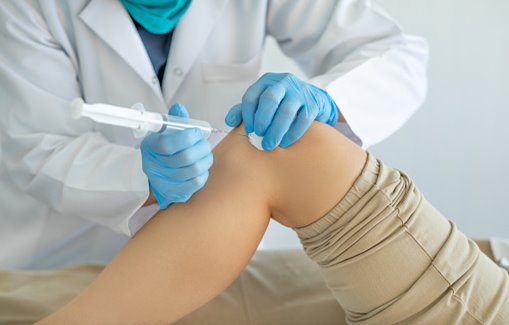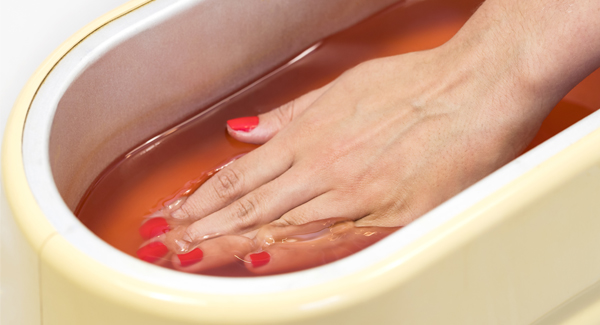Injections for Hand Arthritis
Injections may be an option for relieving arthritis-related hand pain when more conservative treatments have failed.
By Mary Anne Dunkin | May 21, 2021
When joint pain in the hands makes it difficult to maintain daily activities, your doctor’s first advice will likely include activity modification — that, is avoiding activities that cause or worsen pain — as well as splints or braces to stabilize and support the painful joints, pain-relieving gels or rubs, or acetaminophen or nonsteroidal anti-inflammatory drug (NSAIDs) pills or capsules. If those conservative measures fail to relieve pain, the next step may be injections into the affected joints.
Corticosteroid injections are usually the first and by far the most common injections for hand joints, says Amy Ladd, MD, a hand and upper extremity surgeon and chief of the Robert A. Chase Hand and Upper Limb Center at Stanford University Medical Center. The joint that is most commonly treated with injections is the carpometacarpal (CMC) joint at the base of the thumb — one of five CMCs in the hand, this one called the trapeziometacarpal. However, any joint can receive an injection, and other types of injections — some off-label or experimental — may be beneficial for relieving pain, says Dr. Ladd.
Here’s what you need to know about each type.
Corticosteroids
Injections of corticosteroids, or “steroids,” directly into the joints of the hand are used to relieve pain and inflammation for different forms of arthritis. For osteoarthritis, the most commonly injected joints are the CMC joints at the base of the thumbs, followed by the distal phalangeal (DIP) joints, which are the joints closest to the nail, says Jennifer Wolf, MD, professor of orthopedic surgery and rehabilitation medicine at the University of Chicago.
For rheumatoid arthritis (RA) and psoriatic arthritis (PsA), the most commonly injected joints are the metacarpophalangeal (MCP) joints, which are the knuckles, or the joints closest to the hand. Less common is the proximal Interphalangeal (PIP) joint, the joint in the middle of the finger, says Dr. Wolf.
Although the injections are intended to provide localized relief without systemic side effects, research shows they may have stronger systemic effects than once believed. For example, people with diabetes should be aware that corticosteroid injections can raise blood sugar for 24 to 48 hours, says Dr. Wolf.
Because they can potentially suppress the immune system’s response to infection, they should never be used for arthritis that is triggered by an infection, called infectious arthritis. Doctors also may hesitate to give these injections within a few months of a planned surgery, says Dr. Ladd, because they suppress the immune system, making infection after surgery more likely. It may also be wise to avoid injections within a couple of weeks of receiving vaccines, including a COVID-19 vaccine, she says. Dr. Ladd recommends checking with your doctor about the most recent recommendations about vaccines.
Because corticosteroid injections can cause thinning of the bone and tissue, “Most doctors don’t do more than two or three injections per joint, spaced out for more than a year or two,” Dr. Ladd says. Although people respond differently to them, the first is usually the most effective; subsequent injections tend to provide less relief or for a shorter time.
Injections in the hand can be a useful tool for managing arthritis pain. They deliver relief directly into the joint or around it, and many people notice reduced discomfort and improved function afterward. Your gift helps keep practical insights on pain relief available to all. Please make a gift today.
Anesthetics
The second most common type of injection is an anesthetic, typically lidocaine. Anesthetic injections can be used for pain in any joint of the hand, says Dr. Wolf.
These may be administered alone, but often they are injected along with a corticosteroid to provide immediate pain relief while waiting for the corticosteroid to take effect.
Their most common use may be for diagnosis, says Dr. Wolf. If the location of pain is not clear, the doctor might inject the suspected joint with lidocaine. “If we numb it up and your pain is better, we know that it is coming from that joint,” she says.
Hyaluronic Acid Substitutes
For OA pain in the trapeziometacarpal, some doctors may consider giving injections of hyaluronic acid (HA), called viscosupplementation. HA is chemically similar to a substance that gives your natural joint fluid its viscosity, and its breakdown in the joint fluid is thought to lead to pain and stiffness; replacing it by injection may provide relief.
Hyaluronic acid substitutes are classified by the Food and Drug Administration (FDA) as medical devices, not drugs. Although HA is approved by the FDA only for knee OA, some doctors inject it for — and people have found relief from — OA pain at the base of the thumb. Studies of HA’s effectiveness for this purpose have been mixed. In some, the injections were associated with reduced pain and improved grip strength; in others HA injections showed no more effectiveness than placebo injections. Factors such as specific HA formulations, injection techniques and injection schedule may have accounted for those differences.
If corticosteroid injections haven’t helped, if there is no evidence of inflammation or if a person has diabetes or other reasons to avoid corticosteroids, hyaluronic acid injections may be an option. They are usually given in a series of three injections about three months apart. Because they are approved only for use in the knee, insurance may not cover hand joint injections, says Dr. Wolf.
Other Options
Less common joint injections that may have a place in treating hand arthritis include platelet rich plasma (PRP) and prolotherapy, says Dr. Ladd.
PRP treatment involves drawing some of your own blood, separating the plasma from the rest of the blood, and then injecting it into the painful joint. Once in the joint, the plasma breaks down and releases anti-inflammatory cytokines and growth factors into the joint intended to trigger the body’s natural healing process. Although the injections have received the most use — and attention — for problems like tennis elbow and Achilles tendon tears, a few small studies suggest they are helpful for OA at the base of the thumb, says Dr. Ladd. Two ongoing studies of PRP injections for OA at the base of the thumb are registered in ClinicalTrials.gov. Neither has reported results yet.
Prolotherapy involves injecting a natural irritant — usually dextrose, a sugar — into the painful joint, says Dr. Ladd. Evidence supporting prolotherapy’s effectiveness is scarce and Dr. Ladd does not use it. The theory is that the irritation draws blood flow to the area and stimulates the release of the body’s natural growth factors to repair the painful tissue. Although prolotherapy’s most common use is for back pain, at least one small, randomized study suggested it may be effective for osteoarthritis pain in DIP, PIP and thumb CMC joints of the hand. In the study, injections of dextrose and lidocaine — compared with injections of lidocaine alone — were associated with significantly more improvement in pain with finger movement and greater improvement in flexion range of motion.
Injections in the hand can be a useful tool for managing arthritis pain. They deliver relief directly into the joint or around it, and many people notice reduced discomfort and improved function afterward. Your gift helps keep practical insights on pain relief available to all. Please make a gift today.

Stay in the Know. Live in the Yes.
Get involved with the arthritis community. Tell us a little about yourself and, based on your interests, you’ll receive emails packed with the latest information and resources to live your best life and connect with others.


